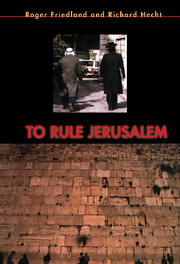Book contents
- Frontmatter
- Contents
- List of Illustrations
- Preface
- Acknowledgments
- Introduction
- 1 A Fearful Fusion
- Part I The Two Zions: Jews Against Zionism in Jerusalem
- Part II Zion Divine: Jerusalem as the Messianic Central City
- Part III Birth of a Nation
- Part IV Heart of Stone
- 16 Al-Quds and Tunis
- 17 The City That Ate Palestine
- 18 Heart of Stone
- Notes
- Index
17 - The City That Ate Palestine
Published online by Cambridge University Press: 13 May 2010
- Frontmatter
- Contents
- List of Illustrations
- Preface
- Acknowledgments
- Introduction
- 1 A Fearful Fusion
- Part I The Two Zions: Jews Against Zionism in Jerusalem
- Part II Zion Divine: Jerusalem as the Messianic Central City
- Part III Birth of a Nation
- Part IV Heart of Stone
- 16 Al-Quds and Tunis
- 17 The City That Ate Palestine
- 18 Heart of Stone
- Notes
- Index
Summary
Around Jerusalem, the winds of peace carry dust. As soon as Egypt, Syria, Jordan, Lebanon, and Israel agreed to the peace conference in Madrid in October 1991, Jerusalem had been put in play. Ariel Sharon, appointed minister of housing in 1990, architect of the war in Lebanon, had already chosen Jerusalem as his last and best front. Religious nationalist Jews, too, looked to Zion as the best place to assert and defend their dream, to protect redemption from the promises of an illusory peace.
Silwan, a poor Arab village hugging the steep southeastern slopes below the Old City, in the shadow of the leaded dome of al-Aqsa mosque, was one of the religious Zionists’ most provocative destinations. Jews, mainly Yemenite, had lived there until the Palestinians rose against the Jews in the 1930s. After becoming part of Israeli Jerusalem in 1967, Silwan remained exclusively Arab, inhabited by many Palestinians from Deir Yassin and Hebron.
Silwan was the politically perfect point from which to assert the primacy of Jewish property rights to Jerusalem. The Jews’ claim to Zion originated here. Extensive archaeological excavations had determined that Silwan, known in Hebrew as Shiloah, was the site where King David founded his city. At its base lies the Gihon spring whose waters were used in the coronation of Israelite kings. Israeli schoolchildren used to make pilgrimage to the site, candles in hand. During the intifada, its young Palestinian boys and girls had the same deadly faceoff s with Israeli soldiers as they did everywhere else. Israelis and tourists alike stopped visiting the area.
- Type
- Chapter
- Information
- To Rule Jerusalem , pp. 436 - 463Publisher: Cambridge University PressPrint publication year: 1996



